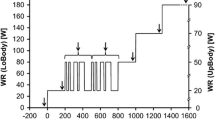Summary
Different criteria for \(\dot V\)O2 max in a progressive bicycle exercise were studied in 115 healthy subjects. In the repeated progressive tests performed on 16 men, aged 25–35 years, three types of \(\dot V\)O2 response against work load were noticed: a linear increase, an unexpectedly high increase, and a plateau; the last two only appearing when \(\dot V\)O2 max was achieved. The last three \(\dot V\)O2 values at least were required to define the plateau. Most commonly, subjective exhaustion was achieved, respiratory quotient (R) was over 1.15 and maximal heart rate (HR) at the estimated level for age, though \(\dot V\)O2 max was not achieved. No significant differences were found between “peak \(\dot V\)O2” in the first progressive test (mean=2.95 l/min), the second progressive test (mean=3.14 l/min), or the constant-load test (mean=3.05 l/min). In the progressive test performed once on 55 men and 44 women, aged 35–62 years, subjective exhaustion was achieved by most of the subjects, but the plateau in \(\dot V\)O2 was shown only in 17 subjects, and the peak \(\dot V\)O2 values were somewhat lower than expected. Moreover, R max did not correlate with peak \(\dot V\)O2, and was over 1.15 only in 9 subjects, and HR max was often below the estimated level. Thus, the progressive test appeared to be convenient in testing the physical work capacity of the subjects, but the establishment of the physiological maximum was more difficult: the relatively uncommon plateau in \(\dot V\)O2 was the only useful criterion for \(\dot V\)O2 max, the value of other criteria being unacceptable.
Similar content being viewed by others
References
Andersen KL, Hermansen L (1965) Aerobic work capacity in middle-aged Norwegian men. J Appl Physiol 20: 432–436
åstrand I (1960) Aerobic work capacity in men and women, with special reference to age. Acta Physiol Scand [Suppl] 169: 1–92
åstrand P-O (1952) Experimental studies of physical working capacity in relation to sex and age. Munksgaard, Copenhagen, pp 15–37
åstrand P-O, Rodahl K (1977) Evaluation of physical work capacity on the basis of tests. In: Textbook of work physiology. McGraw-Hill, New York, pp 331–365
Binkhorst RA, Leeuwen P van (1963) A rapid method for the determination of aerobic capacity. Int Z Angew Physiol 19: 459–467
Davies CTM (1968) Limitations to the prediction of maximum oxygen intake from cardiac frequency measurements. J Appl Physiol 24: 700–706
Froelicher VF, Brammel H, Davis G, Noguera I, Stewart A, Lancaster MC (1974) A comparison of the reproducibility and physiologic response to three maximal treadmill exercise protocols. Chest 65: 512–517
Issekutz B, Birkhead NC, Rodahl K (1962) Use of respiratory quotients in assessment of aerobic work capacity. J Appl Physiol 17: 47–50
Katch VL, Katch FI (1973) The relationship between aerobic power and measured work-output on a progressive step increment bicycle test. Med Sci Sports 5: 22–28
Maksud MG, Coutts KD (1971) Comparison of a continuous and discontinuous graded treadmill test for maximal oxygen uptake. Med Sci Sports 3: 63–65
McArdle WD, Katch FI, Pechar GS (1973) Comparison of continuous and discontinuous treadmill and bicycle tests for max \(\dot V\)O2. Med Sci Sports 5: 156–160
Mitchell JH, Sproule BJ, Chapman CB (1958) The physiological meaning of the maximal oxygen intake test. J Clin Invest 37: 538–547
Nagle F, Balke B, Baptista G, Alleyia J, Howley E (1971) Compatibility of progressive treadmill, bicycle and step tests based on oxygen uptake responses. Med Sci Sports 3: 149–154
Ouellet Y, Poh SC, Becklake MR (1969) Circulatory factors limiting maximal aerobic exercise capacity. J Appl Physiol 27: 874–880
Robinson S (1938) Experimental studies of physical fitness in relation to age. Arbeitsphysiologie 10: 251–323
Taylor HL, Buskirk E, Henschel A (1955) Maximal oxygen intake as an objective measure of cardiorespiratory performance. J Appl Physiol 8: 73–80
Wasserman K, Whipp BJ, Casaburi R, Beaver WL (1977) Carbon dioxide flow and exercise hyperpnea. Am Rev Respir Dis 115: 225–237
Wilhelmsen L, Tibblin G, Fodor J, Werkö L (1971) A multifactorial primary preventive trial in Gothenburg, Sweden. In: Larsen A, Malmborg RO (eds) Coronary heart disease and physical fitness. Munksgaard, Copenhagen, pp 266–270
Wyndham CH (1967) Submaximal tests for estimating maximum oxygen intake. Can Med Ass J 96: 736–742
Author information
Authors and Affiliations
Rights and permissions
About this article
Cite this article
NiemelÄ, K., Palatsi, I., Linnaluoto, M. et al. Criteria for maximum oxygen uptake in progressive bicycle tests. Europ. J. Appl. Physiol. 44, 51–59 (1980). https://doi.org/10.1007/BF00421763
Accepted:
Issue Date:
DOI: https://doi.org/10.1007/BF00421763




